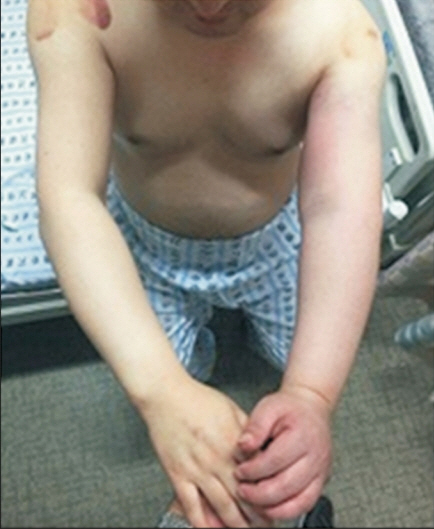Ann Rehabil Med.
2021 Apr;45(2):160-164. 10.5535/arm.20118.
Upper Extremity Deep Vein Thrombosis After Botulinum Toxin Injection: A Case Report
- Affiliations
-
- 1Department of Rehabilitation Medicine, Kwangju Christian Hospital, Gwangju, Korea
- KMID: 2515397
- DOI: http://doi.org/10.5535/arm.20118
Abstract
- Botulinum toxin (BoNT) injection is widely used to improve spasticity. However, after the treatment, the patient may experience pain, inflammation, swelling and redness at the injection site. In this case, we addressed deep vein thrombosis (DVT) after BoNT treatment of the upper limb. A male aged 37 years had spasticity and dystonia in his left upper extremity. BoNT-A 100 U was injected into the left biceps brachii and an equal amount into the brachialis to relieve spasticity. After three days, he developed redness and painful swelling in the left upper arm and the next day, through the upper extremity computed tomography venography, DVT was identified in the left cephalic vein. The thrombus resolved after the anticoagulation therapy with rivaroxaban (Xarelto). We hypothesized the role of mainly three mechanisms in the development of DVT in this case: repetitive strenuous activity, relative stasis due to reduced muscle tone, and possible direct mechanical damage to the vessel wall.
Figure
Reference
-
1. Cote TR, Mohan AK, Polder JA, Walton MK, Braun MM. Botulinum toxin type A injections: adverse events reported to the US Food and Drug Administration in therapeutic and cosmetic cases. J Am Acad Dermatol. 2005; 53:407–15.2. Mines ML, Pacheco T, Castel-Lacana E, de Boissezon X, Marque P, Montastruc F. Venous thrombosis after botulinum therapy in lower limb: a case report and literature review. Ann Phys Rehabil Med. 2019; 62:457–8.
Article3. Pisani LR, Bramanti P, Calabro RS. A case of thrombosis of subcutaneous anterior chest veins (Mondor’s disease) as an unusual complication of botulinum type A injection. Blood Coagul Fibrinolysis. 2015; 26:685–6.
Article4. Kucher N. Clinical practice: deep-vein thrombosis of the upper extremities. N Engl J Med. 2011; 364:861–9.5. Illig KA, Doyle AJ. A comprehensive review of PagetSchroetter syndrome. J Vasc Surg. 2010; 51:1538–47.
Article6. Zell L, Kindermann W, Marschall F, Scheffler P, Gross J, Buchter A. Paget-Schroetter syndrome in sports activities: case study and literature review. Angiology. 2001; 52:337–42.7. Green D, Hartwig D, Chen D, Soltysik RC, Yarnold PR. Spinal Cord Injury Risk Assessment for Thromboembolism (SPIRATE Study). Am J Phys Med Rehabil. 2003; 82:950–6.
Article8. Uppsala Monitoring Centre. The use of the WHOUMC system for standardized case causality assessment [Internet]. Geneva, Switzerland: World Health Organization;2013. [cited 2021 Mar 1]. Available from: https://www.who.int/publications/m/item/WHO-causality-assessment.9. Moore N, Berdai D, Blin P, Droz C. Pharmacovigilance: the next chapter. Therapie. 2019; 74:557–67.10. Fathi M, Fathi H, Mazloumi M, Khalilzadeh O, Amanpour S, Meysamie A, et al. Preventive effect of botulinum toxin A in microanastomotic thrombosis: a rabbit model. J Plast Reconstr Aesthet Surg. 2010; 63:e720–4.
Article
- Full Text Links
- Actions
-
Cited
- CITED
-
- Close
- Share
- Similar articles
-
- Upper Extremity Deep Vein Thrombosis after Clavicle Fracture and Immobilization
- A Case of Upper Extremity Deep Vein Thrombosis and Pulmonary Thromboembolism in a Severely Obese Man
- Management of Venous Thrombosis in Atypical Location
- The Incidence of Deep Vein Thrombosis in the Lower Extremity
- A Case with Upper Extremity Deep Vein Thrombosis after in vitro Fertilization





